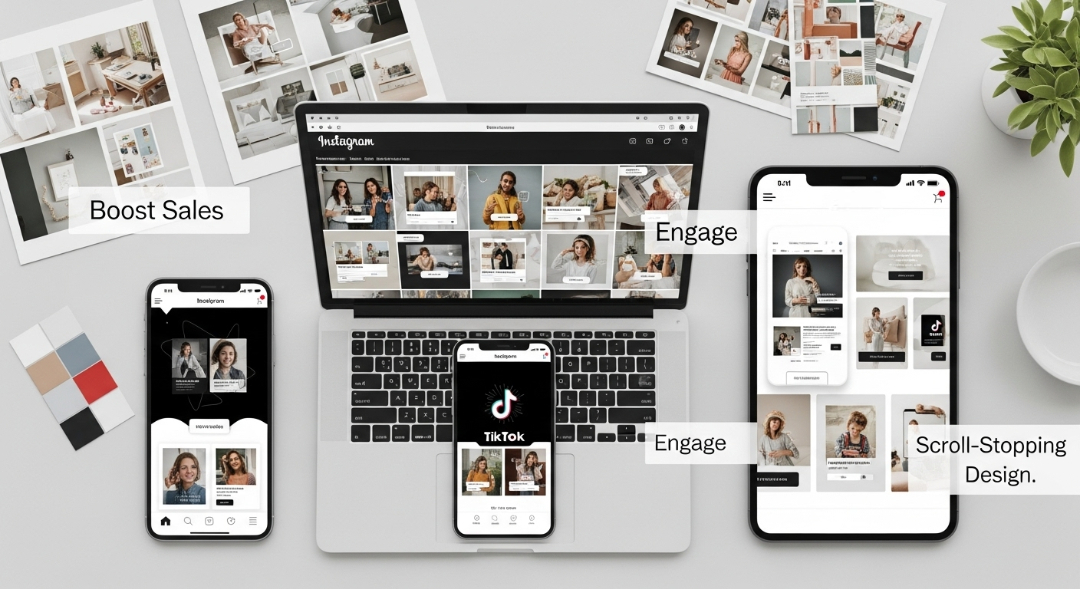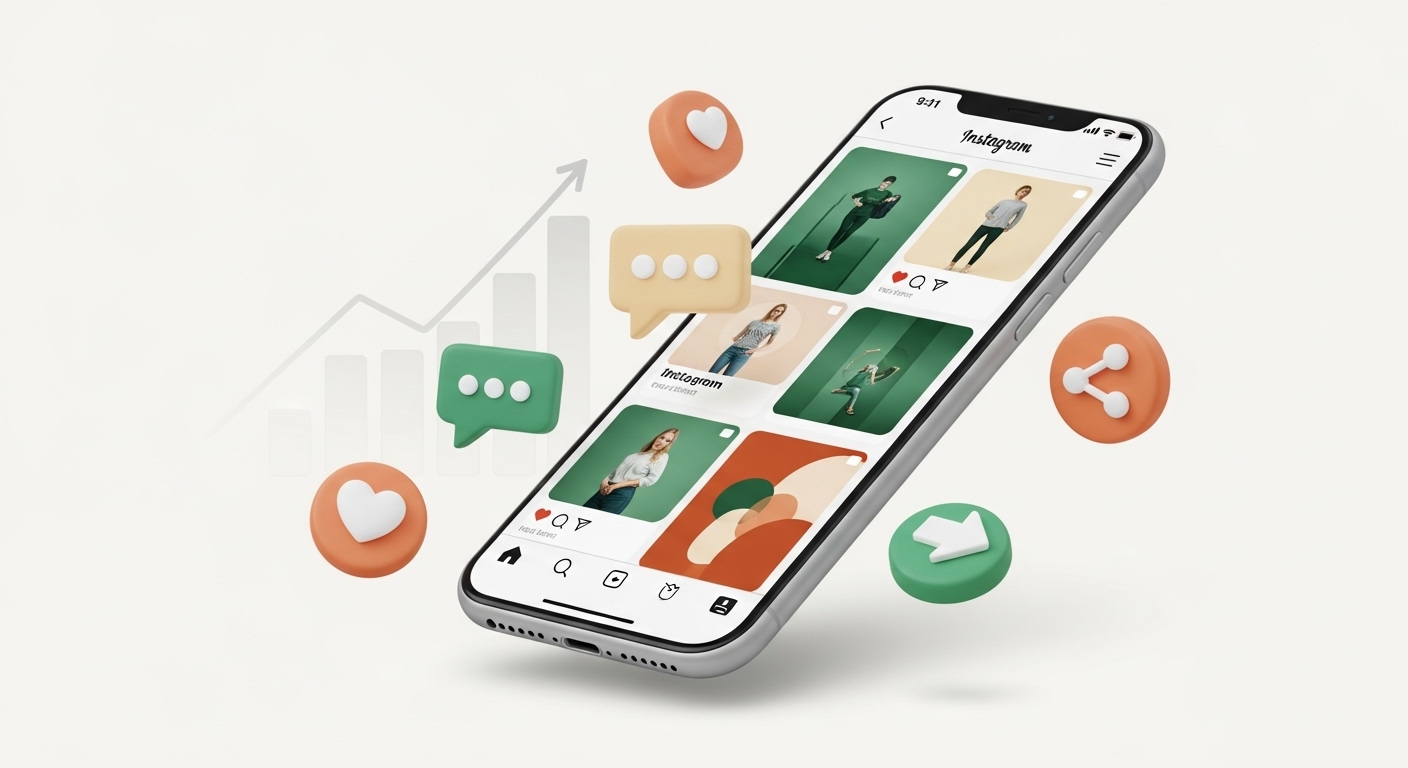You’re scrolling through Instagram, and suddenly you stop. A perfectly designed post catches your eye, showcases a product you didn’t know you needed, and within three taps, you’ve made a purchase. That’s the power of strategic social media design and it’s not magic, it’s science.
Every day, millions of potential customers are scrolling past your competitors’ content, but with the right visual strategies, you can make them stop, engage, and buy from you instead. The difference between a scroll and a sale often comes down to design choices that take seconds to implement but can transform your business overnight.
The numbers don’t lie: businesses that prioritize visual content see significant improvements in conversion rates, some Studies show that visual content improves conversion rates dramaticallyup to 200% increases when leveraging user-generated content effectively.
Whether you’re a small business owner or managing a large brand, these proven design strategies will help you maximize your social media ROI. Services like unlimited graphic design help brands consistently produce scroll-stopping content.
TL;DR
- Transform your social media visuals into sales-generating machines
- Key Stat: Up to 200% increase in conversion rates with strategic design
- Priority: Mobile-first design (70% of social shopping happens on mobile)
- Top Trends 2025: Vertical videos, UGC campaigns, AI graphics, virtual mascots
- Best Platforms: Instagram (visual products), TikTok (demos), Facebook (high-ticket), Pinterest (lifestyle)
- Quick Win: Implement the 80/20 rule (80% value content, 20% promotional)
- Must-Have Elements: Clear CTAs, authentic UGC, consistent branding, mobile optimization
The Foundation: Professional Profile Design
Your social media profile serves as your digital storefront, and first impressions matter more than ever. A professional, trustworthy profile design sets the stage for everything else you do on social media.
Key Elements for Sales-Driven Profiles
- Consistent branding across all platforms with recognizable logos and color schemes
- Clear value propositions in bio sections that immediately communicate what you offer
- Professional photography that reflects your brand quality and attention to detail
- Strategic use of highlights on Instagram and featured content on other platforms to showcase bestsellers
- Contact information and shopping links prominently displayed for easy purchasing
Your profile should answer three critical questions within seconds: What do you sell? Why should I care? How can I buy?
Visual Content That Converts: The Science Behind Sales
The most successful social media designs don’t just look good, they’re strategically crafted to drive action. Visual content significantly impacts sales and conversion rates across all sectors, with high-quality product images, videos, and interactive graphics enabling businesses to communicate value more effectively.
Video Content: The Conversion Champion
Video content has emerged as the ultimate conversion tool, with product-related videos directly correlating to higher social media conversion rates. Videos serve double duty by showcasing products in action while building emotional connections with potential buyers.
High-Converting Video Design Elements:
- Mobile-first vertical formats for TikTok, Instagram Reels, and YouTube Shorts
- Product demonstrations that show real-world usage and benefits
- Before-and-after sequences that highlight transformation or results
- Lifestyle integration showing products in aspirational settings
- Clear calls-to-action with compelling reasons to act now
The key is creating videos that don’t just inform, they inspire action and make purchasing feel like the natural next step.
The 2025 Design Trends That Drive Sales
This year brings exciting opportunities for brands willing to embrace cutting-edge design approaches that resonate with modern consumers.
Interactive and Immersive Experiences
User-Generated Content Integration: Brands leveraging UGC across their digital channels experience increased conversions because authentic customer experiences build trust faster than traditional advertising. Create campaigns that encourage customers to share their experiences through hashtags, challenges, or photo contests.
Virtual Mascots and Avatars: More brands are introducing or revamping digital mascots to engage audiences on a personal level. These virtual characters assist with customer service and become the face of campaigns, creating memorable brand interactions that drive loyalty and sales.
AI-Enhanced Graphics: Posting AI-generated graphics and asking followers for opinions creates engagement while showcasing innovation. This approach positions your brand as forward-thinking and creates conversation opportunities that can lead to sales discussions.
Design Elements That Convert
Strategic Color Psychology: Use colors that align with your brand personality while triggering desired emotions. Red creates urgency, blue builds trust, and green suggests growth and prosperity. Test different color combinations to see what resonates with your audience.
Typography That Speaks: Choose fonts that reflect your brand voice and are easily readable across all devices. Bold, attention-grabbing headlines combined with clean, professional body text create hierarchy and guide users toward purchase decisions.
Whitespace for Focus: Don’t overcrowd your designs. Strategic use of whitespace draws attention to key elements like product features, pricing, and call-to-action buttons. Clean, uncluttered designs perform better than busy, overwhelming layouts.
Platform-Specific Design Strategies
Each social media platform has unique characteristics that require tailored approaches for maximum sales impact.
Instagram: Visual Storytelling That Sells
Instagram’s visual-first nature makes it ideal for product showcasing. Create cohesive feeds that tell your brand story while highlighting products naturally within lifestyle contexts.
Use Instagram Stories and Reels for behind-the-scenes content and product launches, and leverage Shopping tags for seamless purchasing experiences.
Instagram Design Best Practices
- Maintain consistent visual themes and color palettes
- Use high-quality product photography with lifestyle elements
- Create story highlights that serve as permanent product showcases
- Design carousel posts that encourage swiping and engagement
TikTok: Authentic Content That Converts
TikTok’s algorithm rewards authentic, entertaining content over polished advertisements. Focus on creating relatable content that showcases your products solving real problems or enhancing daily life. Educational content (edutainment) that entertains while informing is particularly effective on this platform.
Facebook: Community-Driven Sales
Facebook’s power is in communities surrounding your brand. Leverage Facebook Groups, Live streaming, and segmented product posts to build stronger relationships with future buyers. The platform’s older audience tends to have greater purchasing power, which makes it perfect for high-ticket goods.
Pinterest: Visual Discovery Engine
Pinterest consumers are proactively looking for solutions and ideas, which means it is a great platform to be driving traffic to e-commerce websites. Design very appealing pins that depict your products in inspiring contexts, and utilize rich pins to give in-depth product information within the platform itself.
Content Mix Strategy: The 80/20 Rule
Avoid the common mistake of constantly pushing products, which turns followers off. Instead, follow the 80/20 rule: 80% of your content should educate, entertain, or inspire, while only 20% should be directly promotional.
Content Categories That Drive Sales
- Educational content that positions you as an expert in your field
- Behind-the-scenes content that builds trust and transparency
- Customer success stories that provide social proof
- Lifestyle content that shows products in aspirational contexts
- Interactive content like polls, quizzes, and Q&As that boost engagement
This balanced approach keeps your audience engaged while naturally introducing your products as solutions to their problems.
Call-to-Action Design: The Conversion Catalyst
Your call-to-action (CTA) design can make or break your conversion rates. Effective CTAs are clear, compelling, and create urgency without being pushy.
High-Converting CTA Elements
- Action-oriented language that tells users exactly what to do
- Contrasting colors that make buttons stand out from surrounding content
- Strategic placement in natural reading flow patterns
- Mobile optimization ensuring buttons are easily tappable on all devices
- Value-focused messaging that emphasizes benefits over features
Icons that guide readers or point to specific call-to-action buttons can increase conversions by up to 30%, making them a simple yet powerful addition to your design toolkit.
User-Generated Content: The Trust Builder
User-generated content represents one of the most powerful tools for boosting sales through social media design. When customers share their experiences with your products, they create authentic testimonials that carry more weight than traditional advertising.
UGC Integration Strategies
- Create branded hashtags that encourage customer sharing
- Feature customer photos and videos in your main content feed
- Develop contests and challenges that generate product-focused content
- Share customer testimonials with professional design treatment
- Use UGC in paid advertising campaigns for increased credibility
Visual and social content contribute to a 200% improvement in conversion rates when properly leveraged, making UGC investment a crucial component of your social media sales strategy.
Mobile-First Design: The Non-Negotiable
With the majority of social media consumption happening on mobile devices, mobile-first design isn’t optional—it’s essential. Every design decision should prioritize mobile users’ experience and purchasing journey.
Mobile Optimization Checklist
- Test all content on various device sizes and orientations
- Ensure text remains readable without zooming
- Make buttons large enough for easy tapping
- Optimize loading times for slower connections
- Simplify navigation and purchasing processes
Analytics and Iteration: The Continuous Improvement Cycle
The most successful social media designs evolve based on data and user feedback. Regularly analyze your content performance to identify what resonates with your audience and drives the most conversions.
Key Metrics to Track
- Engagement rates by content type and design style
- Click-through rates on different CTA designs
- Conversion rates from social media traffic
- Time spent viewing different content formats
- Customer acquisition costs by platform and content type
Use this data to refine your design approach continuously, focusing resources on strategies that deliver the best ROI.
Advanced Techniques for Maximum Impact
Limited-Time Offers and Urgency
Running sales or offering limited-time deals creates natural urgency that drives immediate action. Use posts, stories, live videos, and other formats to announce these deals with compelling visual design that emphasizes scarcity and value.
Social Proof Integration
Incorporate elements like customer counts, testimonials, and social media mentions directly into your design layouts. This social proof builds confidence and reduces purchase hesitation.
Personalization at Scale
Use platform features like dynamic product ads and personalized retargeting to show users products they’ve previously viewed or similar items based on their interests. This relevance increases conversion likelihood significantly.
The Future of Social Media Sales Design
As we move further into 2025, several emerging trends will shape the future of social media sales design:
AI-Powered Personalization: Artificial intelligence will enable more sophisticated personalization of content and product recommendations, creating more relevant experiences for each user.
Interactive Shopping Experiences: Augmented reality try-ons, virtual showrooms, and interactive product demonstrations will become standard expectations rather than novelties.
Community-Driven Commerce: Social commerce will continue evolving toward community-based experiences where customers can shop within social groups and get real-time recommendations from peers.
Key Takeaways: Your Social Media Sales Blueprint
- Foundation First: Professional profiles with clear value propositions, consistent branding, and strategic shopping links are your digital storefront, make them count.
- Video Wins: Product demonstration videos consistently outperform static images across all platforms. Focus on vertical, mobile-first formats that show real-world usage.
- Authenticity Sells: User-generated content builds trust faster than polished advertising. Create campaigns that encourage customers to share their experiences.
- Mobile is King: Over 70% of social media shopping happens on mobile devices. Every design decision must prioritize mobile users’ experience.
- Strategic Design: Use color psychology, clear typography, and strategic whitespace to guide users toward purchase decisions naturally.
- Platform Strategy: Instagram for visual products, TikTok for authentic demos, Facebook for community building, Pinterest for lifestyle discovery.
- The 80/20 Rule: 80% of content should educate, entertain, or inspire. Only 20% should be directly promotional to maintain audience engagement.
- Continuous Optimization: Track metrics, test different approaches, and refine your strategy based on what actually drives conversions for your specific audience.
Conclusion: Your Path to Social Media Sales Success
In today’s hyper-visual world, your social media designs aren’t just for likes, they’re your frontline sales force. When crafted strategically, every graphic, video, and CTA becomes a silent seller working 24/7. From scroll-stopping visuals to mobile-first layouts, your design choices shape how your brand is seen and how often your products are sold.
Want to stop guessing and start selling more? Get high-converting social media graphics designed by experts fast. Whether you’re launching a new product or running a campaign, Design Shifu delivers unlimited visuals tailored to your brand and goals.
Book a free demo now and watch your scrolls turn into sales. Or get started with unlimited design today, no contracts, no hassle.
Frequently Asked Questions
1. How can social media design increase product sales conversion rates?
Strategic visuals like sharp product images, clear CTAs, and authentic user content build trust and drive action. Well-designed posts can boost conversions by up to 200% by guiding customers from scroll to sale.
2. What are the best social media design trends for e-commerce in 2025?
Top design trends in 2025 include vertical video, AI-powered graphics, interactive UGC campaigns, and virtual brand mascots. Mobile-first layouts, smart use of whitespace, and AR integration are now must-haves. Authentic storytelling, through behind-the-scenes content and real customer wins continues to build trust and boost conversions.
3. Which social media platforms generate the highest product sales through design?
Instagram leads with Shopping tags and carousel posts, followed by TikTok for authentic product demonstrations and viral content. Facebook excels for higher-ticket items and community-driven sales, while Pinterest serves as a discovery engine for lifestyle products. Platform choice depends on target demographics, product type, and budget allocation.
4. How do I optimize social media visuals for mobile shopping?
Use vertical video formats, large touch-friendly buttons, fast-loading images, and simplified navigation for small screens. Ensure text remains readable without zooming and use contrasting colors for call-to-action buttons. Mobile-first design is crucial since over 70% of social media shopping happens on mobile devices.
5. What visual elements boost social media engagement and sales?
High-converting visuals include UGC, lifestyle shots, before-and-after demos, and interactive content. Strong branding, smart color use, and demo videos drive the highest engagement and conversions.
6. How can small businesses compete with big brands on social media design?
Focus on authentic, personal connections rather than matching big brands’ production budgets. Leverage user-generated content, behind-the-scenes content, and founder stories to build trust and relatability. Consistent posting schedules, personal engagement with comments, and niche-specific content often outperform generic big-brand content.





